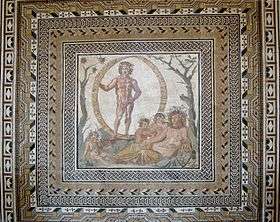Sentinum
 | |
 Shown within Italy | |
| Location | Sassoferrato, Province of Ancona, Marche, Italy |
|---|---|
| Coordinates | 43°25′6.56″N 12°51′8.1″E / 43.4184889°N 12.852250°ECoordinates: 43°25′6.56″N 12°51′8.1″E / 43.4184889°N 12.852250°E |
| Type | Settlement |
| History | |
| Cultures | Ancient Rome |
| Site notes | |
| Condition | Ruined |
| Ownership | Public |
| Management | Soprintendenza per i Beni Archeologici delle Marche |
| Public access | Yes |

Sentinum was an ancient town currently located in the Marche region of Italy. It was situated in the low ground about a kilometre south of the present-day town of Sassoferrato. The ruins of Sentinum were partially excavated in 1890 and the results were published by T. Buccolini.[1] The foundations of the city walls are preserved. The city gates, a road, cisterns, and the remains of houses have been discovered. Notable cultural finds include several mosaic pavements[2] and inscriptions of the latter half of the 3rd century AD, including three important tabulae patronatus, recording legal ratifications of civic appointments of official patrons.
The Battle of Sentinum took place nearby in 295 BC, with the Romans defeating the combined forces of the Samnites and Gauls. During the civil wars of the 40s, Sentinum sided with Mark Antony, but in 41 BC was taken and destroyed by Salvidienus Rufus leading troops of Octavian.[3] It was planned and rebuilt, reurbanized, and continued to exist under the Empire, chartered as a municipium and (as is sometimes supposed) a colonia.
Baths (thermae) dating from the early Empire have yielded a large figured mosaic, preserved in the Museo Nazionale delle Marche. A 2nd-century colored mosaic of Mithra-Sol is conserved in the Glyptothek, Munich; Mithraic bas-relief of animals representing the stages of the initiate's progress were reused in the Church of Santa Croce, and Mithraic inscriptions are recorded.[4]
Civic life at Sentinum seems to have collapsed at the time of the invasion of Alaric I [5] and not to have been renewed.
The site and its environs have been excavated under the joint auspices of the University of Genoa, led by Maura Medri, and the University of Urbino under Sergio Rinaldi Tufi. The site is protected as the Archaeological park of Sentinum.
See also
Notes
- ↑ Princeton Encyclopedia of Classical Sites, s.v. "Sentinum"
- ↑ T. Buccolini (1890). "SASSOFERRATO". Notizie degli scavi di antichità: 346–350.
- ↑ Cassius Dio 48.13.2.5; Appian The Civil Wars 5.30.
- ↑ C. Ramelli, Monumenti mitriaci di Sentinum (1863); Corpus Inscriptionum Latinarum XI, 5736-37.
- ↑ Zosimus 5.37.
References
-
 This article incorporates text from a publication now in the public domain: Chisholm, Hugh, ed. (1911). "Sentinum". Encyclopædia Britannica. 24 (11th ed.). Cambridge University Press. p. 649.
This article incorporates text from a publication now in the public domain: Chisholm, Hugh, ed. (1911). "Sentinum". Encyclopædia Britannica. 24 (11th ed.). Cambridge University Press. p. 649.